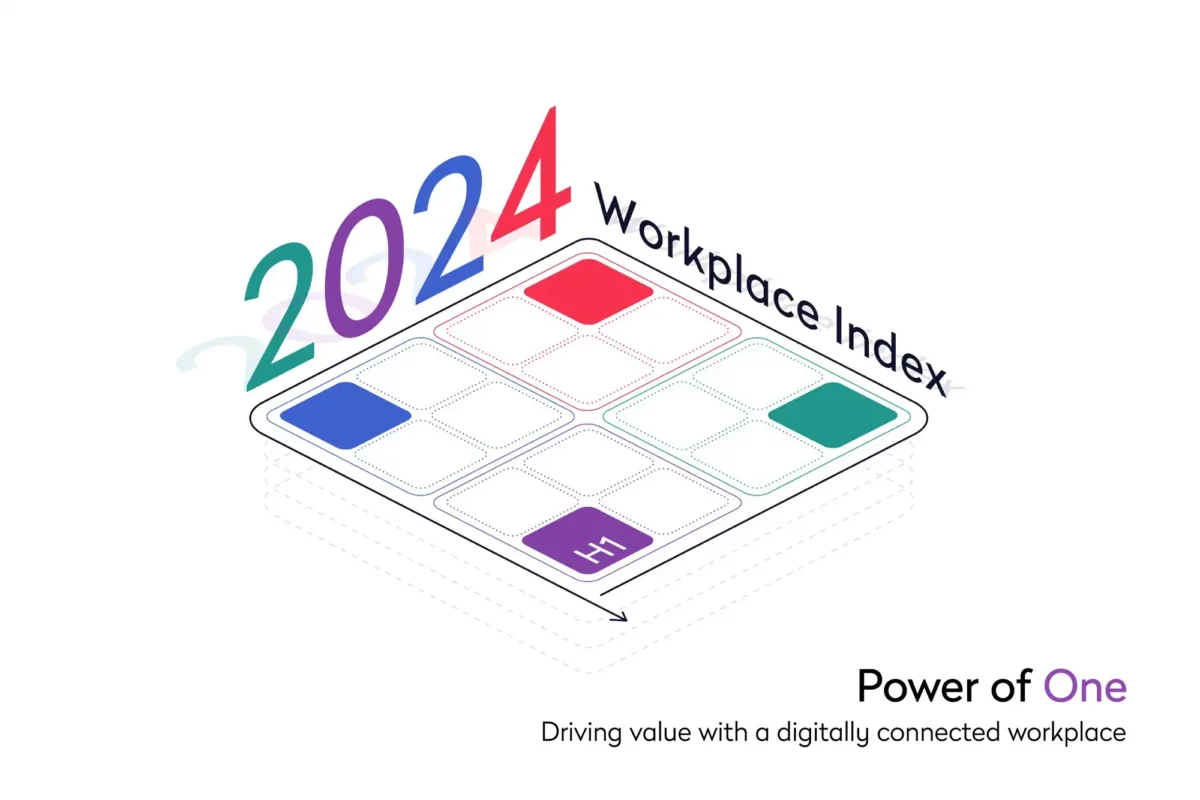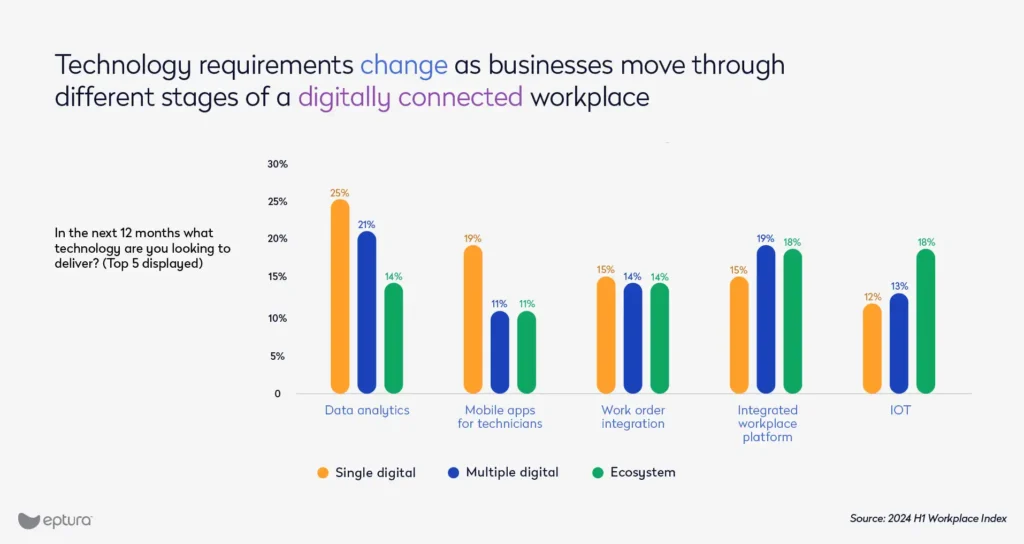
Businesses face ever-mounting pressure to grow revenue and cut costs but disconnected tools and unreliable processes are roadblocks to developing operational efficiencies. Large organizations need enterprise-wide ways to enhance employee collaboration, optimize building and facility costs, and ensure the uptime of revenue-generating assets.
What our recent research shows is that an important part of the solution is a unified worktech platform that can deliver — among many other benefits — the incremental value of a connected workplace.
The 2024 Workplace Index features proprietary research from enterprises in North America, Europe, and Asia Pacific, and leverages anonymous user data from over 5,000 companies and insights from 200 senior-level leaders.
What is a connected workplace?
A connected workplace is a technology-driven environment that promotes seamless communication, collaboration, and data sharing. It integrates people, devices, and systems to create a productive ecosystem, leveraging technologies like Internet of Things (IoT), cloud computing, and artificial intelligence (AI) to enhance efficiency.
Data analytics provides valuable insights into employee productivity and market trends, informing strategic decisions. A connected workplace prioritizes employee well-being with smart office designs and space planning.
Overall, a connected workplace supports innovation, fosters collaboration, and enhances the employee experience, improving employee productivity and retention while cutting operational costs.
Eptura’s most recent Workplace Index report includes a detailed description of the four-stage path companies tend to take when moving toward a complexly connected workplace. Looking at the stages makes it easier to understand what a connected workplace is and the ways it can deliver incremental value.
Stage 1 is that first move from manual methods to a single point digital solution. Here an organization might move from a paper-based visitors log to a stand-alone digital visitor management system. There’s more visibility into the data, but the view is still narrow. At Stage 2, organizations can combine solutions from a single vendor, which helps them cut management and software costs.
By Stage 3, they’ve made the move to a single platform that creates integrated use cases for cross-platform functionality, digital mapping of the workplace, and access to cross-functional data. Because they can now share data across workflows and between teams, organizations can find new operational efficiencies.
Stage 4 is where it all comes together across the enterprise with an integrated ecosystem delivering real-time predictive analysis and modeling backed by IoT asset communication and digital twins. Here, organizations can leverage a smart, interconnected system to deliver optimal outcomes for facility, assets, and employee experience at all their spaces, across multiple locations.
What are the benefits of a connected workplace?
A connected workplace can deliver a wide range of benefits across a large enterprise — for employees, office managers, facility and maintenance teams, and the overall organization.
More connection and collaboration for employees from:
- Enhanced collaboration: Real-time communication tools for seamless teamwork, regardless of location
- Simplified scheduling: Centralized systems for booking meeting rooms and resources mean less time spent juggling schedules
Data-driven decisions for office managers and real estate planners through:
- Space optimization: Real-time occupancy data for maximize space usage and plan layouts efficiently
- Real estate rightsizing: Analytics-based insights into employee productivity and space utilization for informed decision-making
A proactive, preventive focus for facility and maintenance managers, including:
- Proactive maintenance: IoT sensors track equipment health, enabling predictive maintenance and reducing downtime
- Streamlined work orders: Digital platforms for managing maintenance requests, improving response times and accountability
Less spending, stronger return on investments for the overall organization from:
- Cost savings: Improved operational efficiency, less unscheduled downtime, and reduced waste cut overhead costs
- Talent attraction and retention: Modern, tech-enabled workspace appeals to top talent and promotes employee satisfaction
Do senior-level leaders see value in integrated worktech platforms?
Over 50% of the businesses in the report responded that they have implemented or are moving toward implementing an integrated platform. But a large percentage are still at the stage of digitizing manual processes and planning their next moves.
In the area of employee experience, the top three planned implementations for the following 12 months are:
- 25% workplace analytics
- 25% collaboration software
- 15% AI predictive booking
For buildings and facilities, the top three are:
- 17% data analytics
- 15% integrated workplace platform
- 13% facility requests in workplace solutions
While in asset management, the three most popular responses are:
- 22% data analytics
- 17% integrated workplace platform
- 15% work order integration in workplace solutions
Collectively, the top three technologies most operations leaders want to implement in the next 12 months are data analytics, integrated workplace solutions, and collaboration software.

There are some interesting variations between companies depending on where they are in their move to a comprehensive ecosystem. Still, data analytics, work order integration, and an integrated workplace platform remain solidly in the top five responses.
In the end, regardless of their current location on the digital implementation spectrum, companies understand the value of data and an integrated system that helps them deliver a connected workplace.
What’s the incremental value of a connected workplace?
Incremental value is about making smaller, strategic improvements that deliver significant benefits over time. It’s a way to continuously improve without the need for large-scale, disruptive changes.
An important element of worktech, from the features for the workplace to those popular with the facility and maintenance teams, is how it helps with streamlining and strengthening existing workflows, and there are many possible examples from across the enterprise, between departments, and even inside smaller teams.
Implementing visitor management means accurate occupancy numbers
The corporate real estate professional at a large company is already trying to track occupancy numbers and generate utilization rates across multiple facilities but is likely struggling with manual methods or siloed data stuck in unconnected platforms.
It’s not that the workflow doesn’t exist. It’s already there, but the current process is time consuming and prone to errors that make the final reporting unreliable. Or worse: Because the results appear reliable, the company ends up making poor decisions based on bad business intelligence.
The current workflow might start with reviewing paper sign-in logs from multiple spaces. Even if they’re digital, it would be impossible to combine everything easily or accurately because the data lives inside separate platforms. And that’s only the first step in the workflow.
From there, the real estate portfolio manager must combine the occupancy numbers with the current space planning models to calculate utilization rates. Every time even the most detail-oriented professionals move data between formats or platforms, there’s the risk of corruption or loss.
Moving to an integrated platform for visitor management, for example, a company can streamline and standardize the check-in process, benefiting not only employees and visitors who no longer have to deal with crowded lobbies, but everyone else in the organization that could improve existing workflows with access to accurate occupancy data.
Accurate occupancy data helps improve other workflows across the enterprise
A modern unified platform empowers companies to solve these slowdowns and avoid potential errors by automating data capture and simplifying data sharing across departments and between teams.
The real estate portfolio manager can see which facilities are underutilized, a critical first step to rightsizing the company’s spaces. An office manager can look at that same basic data to understand which days of the week are most popular with employees on the hybrid work model. Knowing when in the week the office is busier can help them schedule everything from cleaning and janitorial work to when to restock the breakroom.
In an emergency requiring the evacuation of the facilities, an accurate list of everyone on the premises that’s also sharable in real time becomes invaluable. For the maintenance team, insights into occupancy trends help them schedule routine and project-based maintenance tasks.
If they know Friday mornings tend to be quiet because of the “midweek mountain,” they can, for example, schedule preventive maintenance on the HVAC systems that require them to temporarily turn off the heat in the office.
Realizing the incremental value of a connected workplace
The connected workplace delivers value in many ways, including incrementally. In a modern unified platform, there are no silos, so multiple teams can leverage an improvement in one area across their existing workflows.
So, for example, the integration of a visitor management platform can significantly improve how occupancy data is handled, leading to more streamlined processes and better decision-making through reliable data analytics for multiple departments and teams. And it is these improvements that that are pivotal in enhancing overall workplace efficiency, fostering innovation, and boosting employee productivity and retention.








